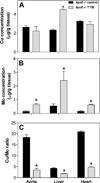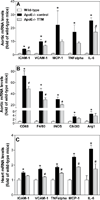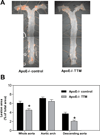Copper chelation by tetrathiomolybdate inhibits vascular inflammation and atherosclerotic lesion development in apolipoprotein E-deficient mice
- PMID: 22770994
- PMCID: PMC3417757
- DOI: 10.1016/j.atherosclerosis.2012.06.013
Copper chelation by tetrathiomolybdate inhibits vascular inflammation and atherosclerotic lesion development in apolipoprotein E-deficient mice
Abstract
Endothelial activation, which is characterized by upregulation of cellular adhesion molecules and pro-inflammatory chemokines and cytokines, and consequent monocyte recruitment to the arterial intima are etiologic factors in atherosclerosis. Redox-active transition metal ions, such as copper and iron, may play an important role in endothelial activation by stimulating redox-sensitive cell signaling pathways. We have shown previously that copper chelation by tetrathiomolybdate (TTM) inhibits LPS-induced acute inflammatory responses in vivo. Here, we investigated whether TTM can inhibit atherosclerotic lesion development in apolipoprotein E-deficient (apoE-/-) mice. We found that 10-week treatment of apoE-/- mice with TTM (33-66 ppm in the diet) reduced serum levels of the copper-containing protein, ceruloplasmin, by 47%, and serum iron by 26%. Tissue levels of "bioavailable" copper, assessed by the copper-to-molybdenum ratio, decreased by 80% in aorta and heart, whereas iron levels of these tissues were not affected by TTM treatment. Furthermore, TTM significantly attenuated atherosclerotic lesion development in whole aorta by 25% and descending aorta by 45% compared to non-TTM treated apoE-/- mice. This anti-atherogenic effect of TTM was accompanied by several anti-inflammatory effects, i.e., significantly decreased serum levels of soluble vascular cell and intercellular adhesion molecules (VCAM-1 and ICAM-1); reduced aortic gene expression of VCAM-1, ICAM-1, monocyte chemotactic protein-1, and pro-inflammatory cytokines; and significantly less aortic accumulation of M1 type macrophages. In contrast, serum levels of oxidized LDL were not reduced by TTM. These data indicate that TTM inhibits atherosclerosis in apoE-/- mice by reducing bioavailable copper and vascular inflammation, not by altering iron homeostasis or reducing oxidative stress.
Copyright © 2012 Elsevier Ireland Ltd. All rights reserved.
Figures





References
-
- Davies MJ, et al. The expression of the adhesion molecules ICAM-1, VCAM-1, PECAM, and E-selectin in human atherosclerosis. J Pathol. 1993;171:223–229. - PubMed
-
- Bourdillon MC, et al. ICAM-1 deficiency reduces atherosclerotic lesions in double-knockout mice (ApoE(−/−)/ICAM-1(−/−)) fed a fat or a chow diet. Arterioscler Thromb Vasc Biol. 2000;20:2630–2635. - PubMed
Publication types
MeSH terms
Substances
Grants and funding
LinkOut - more resources
Full Text Sources
Other Literature Sources
Medical
Research Materials
Miscellaneous

